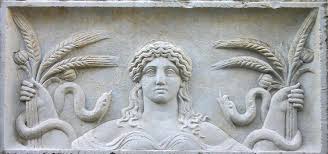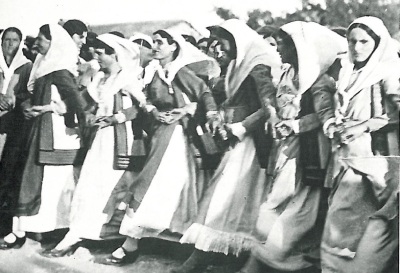Following those footprints........and I take the liberty of copying here the fascinating article by Laura Shannon. Laura Shannon has been researching and teaching traditional women’s ritual dances since 1987. She is considered one of the ‘grandmothers’ of the worldwide Sacred / Circle Dance movement and gives workshops regularly in over twenty countries worldwide. Laura holds an honours degree in Intercultural Studies (1986) and a diploma in Dance Movement Therapy (1990). She has also dedicated much time to primary research in Balkan and Greek villages, learning songs, dances, rituals and textile patterns which have been passed down for many generations, and which embody an age-old worldview of sustainability, community, and reverence for the earth. Laura’s essay ‘Women’s Ritual Dances: An Ancient Source of Healing in Our Times’, was published in Dancing on the Earth. Laura lives partly in Greece and partly in the Findhorn ecological community in Scotland.
Showing posts with label Megara. Show all posts
Showing posts with label Megara. Show all posts
Tuesday, May 10, 2016
Foot-note on Megara...........the "Dance of Persephone"
I couldn't help but laugh when a few days ago I read the article below in the Feminism and Religion Blog, which I subscribe to. In the previous post I explored the idea of "marga" and synchronicity which began when I was writing a little article to submit to the very same Blog (the article, of course, was about Spider Woman, the great connector of all things) In the course of writing my last post I included in the post something about Megara.
Following those footprints........and I take the liberty of copying here the fascinating article by Laura Shannon. Laura Shannon has been researching and teaching traditional women’s ritual dances since 1987. She is considered one of the ‘grandmothers’ of the worldwide Sacred / Circle Dance movement and gives workshops regularly in over twenty countries worldwide. Laura holds an honours degree in Intercultural Studies (1986) and a diploma in Dance Movement Therapy (1990). She has also dedicated much time to primary research in Balkan and Greek villages, learning songs, dances, rituals and textile patterns which have been passed down for many generations, and which embody an age-old worldview of sustainability, community, and reverence for the earth. Laura’s essay ‘Women’s Ritual Dances: An Ancient Source of Healing in Our Times’, was published in Dancing on the Earth. Laura lives partly in Greece and partly in the Findhorn ecological community in Scotland.
Following those footprints........and I take the liberty of copying here the fascinating article by Laura Shannon. Laura Shannon has been researching and teaching traditional women’s ritual dances since 1987. She is considered one of the ‘grandmothers’ of the worldwide Sacred / Circle Dance movement and gives workshops regularly in over twenty countries worldwide. Laura holds an honours degree in Intercultural Studies (1986) and a diploma in Dance Movement Therapy (1990). She has also dedicated much time to primary research in Balkan and Greek villages, learning songs, dances, rituals and textile patterns which have been passed down for many generations, and which embody an age-old worldview of sustainability, community, and reverence for the earth. Laura’s essay ‘Women’s Ritual Dances: An Ancient Source of Healing in Our Times’, was published in Dancing on the Earth. Laura lives partly in Greece and partly in the Findhorn ecological community in Scotland.
Tuesday, May 3, 2016
"Marga"........Following Footprints in the Mythic Sand
Recently I lent the book "Women Who Run With The Wolves" by Clarissa Pinkola Estes to a friend staying at my house. As she was reading it, I was working on a little article called "Spider Woman's Hands" for the Feminism and Religion Blog. She returned the book to me, with the comment that I should re-read it myself, that it would help me to do so. An hour or so later I picked it up, and opened the book at random, and read the text that my eyes immediately fell on. Here's what it was (truly) :
"What are soul needs? They lie in the two realms of nature and creativity. In these realms lives Na'ashje`'ii Asdza`a`, Spider Woman, the Navajo creation Goddess who gives psychic protection to those who seek her. She is in charge of teaching the soul both protection and the love of beauty." (page 196)What are the odds, to open a book at random thusly? I thought of the concept of Marga after I read that, the archetypal/mythic strands in the web that lead us on, refresh our vision of the links.
The "Blog sphere" has been a continuing source of information and inspiration. In 2011 I received a fascinating correspondence from Robur D'Amour, who shared with me his insights about "Marga", having read some of my own posts on synchronicity.
Marga is a term I had not run across before, a concept that resonates with what I've fancifully called "conversations with the world". And to me, those conversation are founded upon a mythic language.
I was pleased that Robur kindly gave me permission to reproduce rich information from his site. http://roburdamour.blogspot.com/2010/05/marga.html. I have not heard from him in years, but remain grateful for his musings.

Marga is a term I had not run across before, a concept that resonates with what I've fancifully called "conversations with the world". And to me, those conversation are founded upon a mythic language.
I was pleased that Robur kindly gave me permission to reproduce rich information from his site. http://roburdamour.blogspot.com/2010/05/marga.html. I have not heard from him in years, but remain grateful for his musings.

"'Marga' is a term that means following a path of signs or symbols that lead a person to their spiritual self. Marga is a bit like finding one's way through a labyrinth, by reading signs that are given to you by the unconscious."
Jung believed that what mattered in life, to him, was to find his spiritual identity. He believed that a person could do this by leading what he termed a 'symbolic life'. Jung wrote:
“when people feel they are living the symbolic life, that they are actors in the divine drama... That gives the only meaning to human life; everything else is banal and you can dismiss it. A career, producing of children, are all maya (illusion) compared to that one thing, that your life is meaningful.”
I think that this idea is the same thing that Joseph Campbell, who was a great admirer of Jung, refers to as 'marga'. It's a way of living, without following any particular creed or any rules worked out and written down by someone else, other than paying attention to what is presented to you by Fate, the Goddess, God, or the unconscious. In The Hero's Journey (p45) Campbell writes:
"Adolf Bastian, a German anthropologist, has meant a great deal to me with just this main idea. The common themes that come out of the collective unconscious he calls elementary ideas.... In India, in art criticism, the elementary ideas are called 'marga', the path. Marga is from a root word 'mrg', which refers to the footprints left by an animal, and you follow that animal. The animal you are trying to follow is your own spiritual self. And the path is indicated by mythological images. Follow the tracks of the animal and you will be led to the animal's home. Who is the animal? The animal is the human spirit. So, following the elementary ideas, you are led to your own deepest spiritual source."
A snippet of that piece can be read on Google books: The Hero's Journey (Marga). In practical terms, this means paying attention to what we see in the world around ourselves, and in particular to symbols presented to us, in dreams and the things we come across in our daily lives. The symbols we see around us are presented to us by - Fate, the Goddess, God, the unconscious, or whatever name you like to give to the thing that we cannot see, but what determines 'what happens next'.
This is the entry for marga, from a Sanskrit dictionary. Following the links in a trail of symbols that are presented to us by the unconscious, amounts to finding one's way through a labyrinth, by reading the signs. Labyrinths and mazes were common features in Elizabethan gardens."
What was interesting to me particularly in this 2011 correspondance was a kind of synchronistic overlay ..... a "crossing of Margas". He wrote that:
"The marga (path of symbols) that I seem to have been unwittingly following is a very curious one, the odd re-occurrence of names that have served as footprints along the way - names similar to "Marga" that represented been syncronistic touchstones. I originally seemed to connect the word marga with Megara, a name that was popularised as the heroine in a Disney version of Hercules. It's only a film for children, but Megara is a very vivid anima archetype.......Megara was originally a Greek word for a fissure in the ground used for sacred rites connected with beliefs about the underworld (the unconscious) and Persephone-Hecate."
This was quite amazing to me, as twenty years prior I found myself obsessed with writing the only short story/novel I've ever written. The novel, The Song of Medusa, ......... an excerpt can be found here. It was inspired by Riane Eisler's Chalice and the Blade and a desire to envision the world of the Goddess, how it might have been in pre-history, and might manifest in today's world. But in the course of the "flow" of the writing, an ancient fictional priestess emerged, a "Singer" who chanted, prophesized, and "spoke with the voice of the Earth" in trance by going into sacred caves and fissures. I did not know at the time about the ways the Oracle of Delphi became entranced, only learning of this later. And, the novel was developed around the Persephone/Hades myth.
Twenty years later, via this correspondance, I learn about Megara. It seems, once again, that in the course of opening to the creative process, we do indeed open to the collective mind.
And the footprints in the sand, glimmering in the light of Marga, can reveal themselves, leading us on.
Labels:
consciousness,
Goddess,
Jung,
Marga,
Megara,
synchronicity,
writing
Subscribe to:
Comments (Atom)









